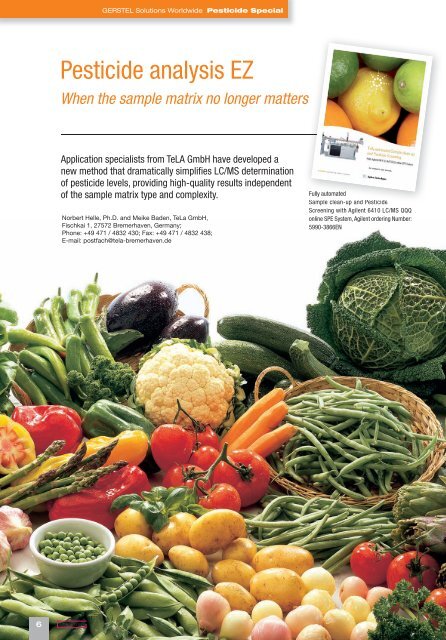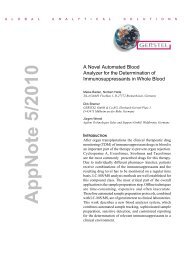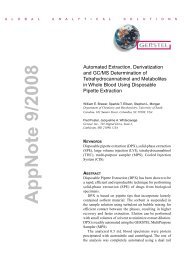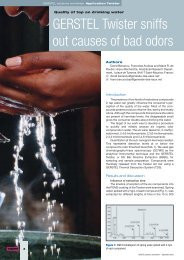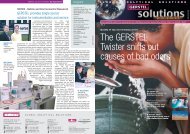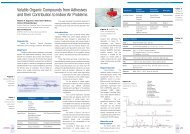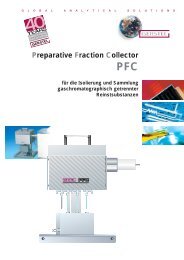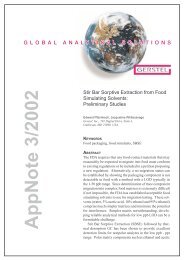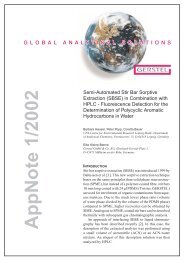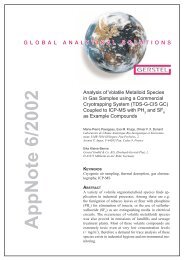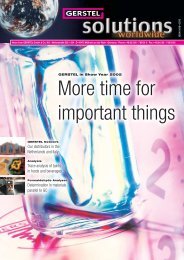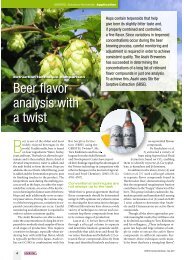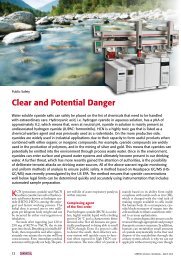Pesticide analysis EZ - When the sample matrix no longer ... - Gerstel
Pesticide analysis EZ - When the sample matrix no longer ... - Gerstel
Pesticide analysis EZ - When the sample matrix no longer ... - Gerstel
You also want an ePaper? Increase the reach of your titles
YUMPU automatically turns print PDFs into web optimized ePapers that Google loves.
GERSTEL Solutions Worldwide <strong>Pesticide</strong> Special<br />
<strong>Pesticide</strong> <strong>analysis</strong> <strong>EZ</strong><br />
<strong>When</strong> <strong>the</strong> <strong>sample</strong> <strong>matrix</strong> <strong>no</strong> <strong>longer</strong> matters<br />
Application specialists from TeLA GmbH have developed a<br />
new method that dramatically simplifi es LC/MS determination<br />
of pesticide levels, providing high-quality results independent<br />
of <strong>the</strong> <strong>sample</strong> <strong>matrix</strong> type and complexity.<br />
Norbert Helle, Ph.D. and Meike Baden, TeLa GmbH,<br />
Fischkai 1, 27572 Bremerhaven, Germany;<br />
Phone: +49 471 / 4832 430; Fax: +49 471 / 4832 438;<br />
E-mail: postfach@tela-bremerhaven.de<br />
Fully automated<br />
Sample clean-up and <strong>Pesticide</strong><br />
Screening with Agilent 6410 LC/MS QQQ<br />
online SPE System, Agilent ordering Number:<br />
5990-3866EN<br />
6
GERSTEL Solutions Worldwide <strong>Pesticide</strong> Special<br />
<strong>Pesticide</strong>s, fungicides and herbicides are needed in<br />
order to provide an adequate supply of food to<br />
<strong>the</strong> ever-growing human population across <strong>the</strong><br />
world. The o<strong>the</strong>r side of <strong>the</strong> coin is that residues of<br />
<strong>the</strong>se types of compounds in foods can<strong>no</strong>t be allowed<br />
to endanger or affect <strong>the</strong> health of <strong>the</strong> consumer. To<br />
ensure that foods do <strong>no</strong>t endanger us, maximum acceptable<br />
levels, sometimes referred to as tolerated levels,<br />
have been established for individual compounds<br />
according to <strong>the</strong> current state of scientific k<strong>no</strong>wledge.<br />
If <strong>the</strong>se levels are exceeded, it would be illegal to market<br />
<strong>the</strong> contaminated product in Europe. Corresponding<br />
laws were established by <strong>the</strong> EU. This legal basis<br />
must be, or, in some cases, already has been, adapted<br />
into National law by EU member states.<br />
In Germany, <strong>the</strong> details on maximum acceptable<br />
levels of residues can be found in <strong>the</strong> German LF-<br />
GB, acronym for <strong>the</strong> compendium of laws governing<br />
Food, Feed and various consumer products. As an<br />
aside, <strong>the</strong> term “consumer products” in this context<br />
spans a great variety of products ranging from packaging<br />
that comes into contact with food, feed or personal<br />
care products to personal care products <strong>the</strong>mselves,<br />
such as cosmetics, tooth paste or shampoo or<br />
o<strong>the</strong>r personal care items that make more than brief<br />
contact with skin or mucous membranes.<br />
Rules, unless properly enforced, are of course<br />
worth less than <strong>the</strong> proverbial paper <strong>the</strong>y were printed<br />
on. In o<strong>the</strong>r words trust is fine, but we should verify<br />
and if needed take corrective action to ensure compliance<br />
and best possible consumer safety. This requires a<br />
network of reliable laboratories, which is <strong>no</strong>t a trivial<br />
matter, as can be seen a bit later in this text.<br />
World-wide, around 700 pesticides are in use, very<br />
few of which can be legally used throughout Europe.<br />
Various compounds classes have been established, but<br />
even <strong>the</strong>se can cover a wide range of polarities, making<br />
it difficult to develop a fast all encompassing <strong>analysis</strong><br />
method.<br />
Still, effective multi-residue methods are in use<br />
for <strong>the</strong> determination of pesticides, helping to ensure<br />
food safety. <strong>When</strong> fruits and vegetables are analyzed<br />
for pesticide residues, often several pesticides are<br />
found. The effects on human health have only been<br />
documented for very few of <strong>the</strong>se compounds or compound<br />
groups.<br />
Tracking down pesticides using<br />
GC/MS and LC/MS<br />
Classical pesticide <strong>analysis</strong> relied on gas chromatography<br />
(GC) using an electron capture detector (ECD)<br />
or a nitrogen phosphorous detector (NPD). The most<br />
widely used detector today is <strong>the</strong> mass selective detector<br />
(MSD).<br />
In Germany, <strong>the</strong> analytes that are mainly in focus<br />
are those listed in <strong>the</strong> DFG S19 method, a multiresidue<br />
method for <strong>the</strong> determination of pesticides<br />
in food, which enjoys Europe-wide recognition. The<br />
<strong>analysis</strong> of <strong>the</strong> 270 compounds listed in <strong>the</strong> S19 method<br />
does, however, require significant <strong>sample</strong> preparation<br />
including a gel chromatography clean-up step to<br />
separate analytes from <strong>the</strong> <strong>matrix</strong>.<br />
Different <strong>analysis</strong> techniques are used for different<br />
types of pesticides. Liquid chromatography (LC)<br />
combined with a mass selective detector (MS) is used<br />
to determine polar to moderately apolar compounds.<br />
Gas chromatography (GC), most often in combination<br />
with a mass selective detector<br />
(MSD) covers apolar to moderately<br />
polar compounds. As<br />
can be seen from this description,<br />
<strong>the</strong>re is some overlap<br />
between <strong>the</strong> techniques.<br />
Recently a new multi-residue<br />
method for <strong>the</strong> determination<br />
of pesticide levels<br />
in fruits and vegetables<br />
was presented (QuECh-<br />
ERS: Quick, Easy, Cheap, Effective,<br />
Rugged & Safe) [*].<br />
Compared to previous methods,<br />
<strong>the</strong> QuEChERS <strong>sample</strong><br />
preparation steps are much<br />
less time-consuming, enabling<br />
<strong>the</strong> preparation of 8<br />
<strong>sample</strong>s in less than 30 minutes.<br />
QuEChERS is a <strong>sample</strong><br />
preparation method well<br />
suited for both GC, GC/MS<br />
and LC/MS <strong>analysis</strong>. The QuEChERS <strong>sample</strong> preparation<br />
steps are listed below.<br />
The main benefit of this <strong>sample</strong> preparation method<br />
is that <strong>the</strong> overall <strong>analysis</strong> is less time-consuming<br />
and less error-prone than more traditional approaches.<br />
Unfortunately, extracts obtained following this procedure<br />
often have a high <strong>matrix</strong> content, which causes<br />
chromatographic problems for GC <strong>analysis</strong> due to residue<br />
build-up in <strong>the</strong> liner unless an automated liner<br />
exchange system such as <strong>the</strong> GERSTEL ALEX is used.<br />
(Cf.: GERSTEL Solutions Worldwide Magazine No. 5<br />
p. 18) (http://www.gerstel.com/solutions_<strong>no</strong>5.htm)<br />
QuEChERS method:<br />
Weigh 10 g of <strong>sample</strong><br />
–> Add 10 ml of Acetonitrile (AcN)<br />
Shake vigorously 1 min<br />
–> Add 4 g MgSO4 and 1 gNaCl<br />
Shake vigorously 1 min<br />
–> Add internal standard solution<br />
Shake 30 sec and centrifuge<br />
–> Take Aliquot of supernatant<br />
–> Add MgSO4 and sorbent<br />
Shake 30 sec and centrifuge<br />
–> Take Aliquot of supernatant<br />
–> inject to GC-MS and LC-MS<br />
The results obtained using QuEChERS <strong>sample</strong><br />
preparation are comparable to those reached using<br />
<strong>the</strong> S19 method. The QuEChERS method is much<br />
faster, requires much less <strong>sample</strong> preparation, covers<br />
a wider range of analytes and is more readily automated.<br />
In addition, much smaller volumes of partly<br />
toxic organic solvents are required, compared with<br />
o<strong>the</strong>r currently used methods for determining pesticides<br />
in fruits and vegetables. In addition to <strong>the</strong> financial<br />
benefits of a much higher laboratory throughput,<br />
<strong>the</strong> cost of materials at around one Euro per <strong>sample</strong><br />
is relatively low.<br />
The limits of QuEChERS are encountered whenever<br />
<strong>sample</strong>s with more complex matrices need to be<br />
analyzed, such as garlic, onion, artichoke or avocado<br />
Calibration curves for nine pesticides, determined using<br />
<strong>the</strong> TeLA GmbH SPE-LC-MS/MS pesticide multi-residue<br />
method.<br />
[*] M. Anastassiades,<br />
S. Lehotay, D. Stajnbaher and<br />
F. Schenck: Fast and easy<br />
multiresidue method employing<br />
acetonitrile extraction/partitioning<br />
and “dispersive solid-phase<br />
extraction” for <strong>the</strong> determination<br />
of pesticide residues in produce.<br />
J AOAC Int 86 (2) (2003)<br />
412-31.<br />
7
GERSTEL Solutions Worldwide <strong>Pesticide</strong> Special<br />
Norbert Helle and Meike Baden in front of <strong>the</strong> SPE LC-MS/MS system used for <strong>the</strong> pesticide<br />
multi-residue method: Agilent Series LC 1200 and a GERSTEL SPE system mounted across<br />
an Agilent 6410 MS/MS Triple Quad.<br />
with much higher fat content. This can lead to problems<br />
with interferences, than can especially influence<br />
quantification unless fur<strong>the</strong>r clean-up steps are performed.<br />
To enable reliable and rugged <strong>analysis</strong> independent of<br />
<strong>the</strong> <strong>sample</strong> <strong>matrix</strong>, we looked for a similarly effective<br />
alternative <strong>sample</strong> preparation procedure. We found<br />
that automated solid phase extraction (SPE) based on<br />
<strong>the</strong> GERSTEL MultiPurpose Sampler (MPS) provided<br />
an excellent solution. The GERSTEL SPE, we have previously<br />
used successfully for a number of applications,<br />
including aflatoxins, chloramphenicol and malachite<br />
green in foods. In summary, we can report that our<br />
automated SPE-LC-MS/MS-ESI multi-residue method<br />
reduces <strong>the</strong> number of manual steps required to<br />
a minimum while increasing laboratory throughput.<br />
The results are solid and reproducible combined with<br />
high sensitivity and good limits of determination.<br />
Instrumental requirements<br />
The GERSTEL SPE was fitted with an injection valve;<br />
<strong>sample</strong> introduction to <strong>the</strong> Agilent LC 1200 was performed<br />
directly by <strong>the</strong> SPE system; detection was performed<br />
using an Agilent 6410 MS/MS Triple Quad instrument.<br />
Sample Preparation: 15 mL of an acetonitrile/water<br />
mixture (80:20) was added to a five gram <strong>sample</strong><br />
of fruit or vegetable for extraction. The SPE cartridge<br />
(M&N C-18ec, 6 mL, 1 g) was conditioned using 10<br />
mL metha<strong>no</strong>l (MeOH) and 10 mL water. All steps in<br />
<strong>the</strong> <strong>sample</strong> preparation procedure, including <strong>sample</strong><br />
introduction were fully automated.<br />
5 mL <strong>sample</strong> was added to <strong>the</strong> cartridge, which was<br />
subsequently rinsed with 5 mL water. Analytes were<br />
<strong>the</strong>n eluted using an acetonitrile/water mixture added<br />
at a flow rate of 600µL/min. In contrast to most manual<br />
SPE methods, <strong>the</strong> liquid is <strong>no</strong>t aspirated through<br />
<strong>the</strong> cartridge under vacuum, ra<strong>the</strong>r it is added under<br />
positive pressure using a syringe. This means that<br />
flows, and <strong>the</strong>refore also <strong>the</strong> elution speed, are accurately<br />
controlled and results more reproducible. This<br />
holds true even when <strong>sample</strong> <strong>matrix</strong> changes <strong>the</strong> restriction<br />
across <strong>the</strong> cartridge. The eluate was concentrated<br />
for six minutes at 50 °C and <strong>the</strong> residual analytes<br />
taken up in 5 mL of a acetonitrile/formic acid<br />
mixture (30:70).<br />
Sample introduction and analyte separation:<br />
20 µL of <strong>the</strong> cleaned-up extract was introduced directly<br />
to <strong>the</strong> LC/MS-MS System. The temperature of<br />
<strong>the</strong> column (ZorbaxXDB C-18 100x2.1 mm, 1.8 µm<br />
rapid resolution) was set to 50 °C; flow rate: 0.5 mL/<br />
min resulting in a column head pressure of approximately<br />
420 bar. A solvent mixture of 5mM formic acid<br />
(A) and acetonitrile (B) was used as mobile phase<br />
based on <strong>the</strong> following gradient programming: 0 min<br />
(20 % B); 5 min (20 % B), 30 min (90 % B).<br />
Detection: Analytes were detected with positive<br />
Electron Spray Ionization (ESI) using <strong>the</strong> electron<br />
spray ion source or, alternatively, <strong>the</strong> Agilent Multimode<br />
ion source. Our experiments clearly showed that<br />
<strong>the</strong> Multimode source provided significantly lower detection<br />
limits for some pesticides than <strong>the</strong> ESI source.<br />
For o<strong>the</strong>r compounds, however, a lower response was<br />
obtained than with <strong>the</strong> ESI ion source. The settings for<br />
<strong>the</strong> ion source were optimized for <strong>the</strong> flow and eluent<br />
used. The following parameters were used: N 2 temperature:<br />
340 °C; carrier gas flow (N 2): 9 L/min; nebulizer<br />
pressure: 30 psi. The triple quadrupole instrument<br />
was operated in MRM mode, with 5 different time segments,<br />
monitoring two transitions for each pesticide.<br />
In each segment 40 to 50 analytes were monitored.<br />
The proof of <strong>the</strong> pudding<br />
<strong>When</strong> using <strong>the</strong> QuEChERS method, it is necessary<br />
to adapt <strong>the</strong> clean-up steps to <strong>the</strong> <strong>sample</strong> at hand. It<br />
has been clearly shown that for “uncomplicated” matrices,<br />
such as lettuce or cucumber, additional cleanup<br />
steps are <strong>no</strong>t required following <strong>the</strong> acetonitrile/<br />
water extraction.<br />
For complex matrices that contain fat and o<strong>the</strong>r challenging<br />
<strong>matrix</strong> components, fur<strong>the</strong>r clean-up steps<br />
are of course needed. For this purpose we used <strong>the</strong><br />
GERSTEL SPE system.<br />
Raw <strong>sample</strong> extracts were automatically loaded<br />
onto standard SPE cartridges and cleaned. A new cartridge<br />
was used for every <strong>sample</strong> to eliminate crosscontamination.<br />
Macherey-Nagel cartridges containing<br />
C18 reversed phase material were found to produce<br />
excellent, reliable results.<br />
Automated SPE clean-up as described in this article<br />
took around 20 minutes to complete. Apart from<br />
<strong>the</strong> first <strong>sample</strong>, <strong>the</strong> SPE process was performed dur<br />
8
GERSTEL Solutions Worldwide <strong>Pesticide</strong> Special<br />
ing LC/MS or GC/MS <strong>analysis</strong> of <strong>the</strong> preceding <strong>sample</strong>,<br />
ensuring that <strong>the</strong> SPE step was performed without increasing<br />
<strong>the</strong> overall <strong>analysis</strong> time. Once <strong>the</strong> first <strong>sample</strong><br />
had been prepared for <strong>analysis</strong>, <strong>the</strong> LC/MS or GC/MS<br />
system never had to wait idly for <strong>the</strong> next <strong>sample</strong>.<br />
An LC 1200 Rapid Resolution HPLC system from<br />
Agilent Tech<strong>no</strong>logies was used for <strong>the</strong> <strong>analysis</strong>. In order<br />
to achieve good separation combined with method<br />
ruggedness, <strong>the</strong> conscious decision was made to<br />
only seek a moderate reduction of <strong>the</strong> <strong>analysis</strong> time.<br />
The total <strong>analysis</strong> time required to determine around<br />
140 compounds was in <strong>the</strong> order of 35 minutes. This<br />
time period was more than sufficient to prepare <strong>the</strong><br />
following <strong>sample</strong> for just-in-time <strong>sample</strong> introduction<br />
to <strong>the</strong> LC/MS system.<br />
Sample clean-up using SPE contributes <strong>no</strong>t only<br />
to <strong>the</strong> ruggedness of <strong>the</strong> method, it also improves<br />
reproducibility and linearity, among o<strong>the</strong>r things. To<br />
illustrate this, a bell pepper <strong>sample</strong> was spiked with a<br />
pesticide mixture and analyzed.<br />
Following SPE clean-up, retention times and peak<br />
areas of <strong>the</strong> analytes showed excellent reproducibility.<br />
The linearity was excellent, both for polar compounds<br />
like Carbendazim und Thiabendazole as well as for apolar<br />
pesticides like Diazi<strong>no</strong>n und Pirimiphosmethyl.<br />
Orange oil <strong>sample</strong>s were cleaned up using a slightly<br />
modified SPE method. The efficiency of SPE cleanup<br />
is illustrated by <strong>the</strong> fact that <strong>the</strong> intense yellow color<br />
of <strong>the</strong> <strong>sample</strong> was transferred to <strong>the</strong> cartridge while<br />
<strong>the</strong> resulting extract was a clear and colorless liquid.<br />
Recovery for <strong>the</strong> various compounds in this difficult<br />
<strong>matrix</strong> ranged from 70 to 90 % while recoveries from<br />
fruit and vegetable <strong>sample</strong>s were mainly in <strong>the</strong> range<br />
from 80 to 100 %. It is worth <strong>no</strong>ting that <strong>the</strong> Zorbax<br />
SB-C18 Rapid Resolution columns used provided excellent<br />
peak symmetry.<br />
One final comment: Every method must prove its<br />
worth in practice. The test, as always, is in <strong>the</strong> <strong>analysis</strong><br />
of real world <strong>sample</strong>s. To prove <strong>the</strong> validity of our<br />
Overlay medium polarity sections of 8 different chromatograms:<br />
8 separate <strong>sample</strong> preparations and injections of a bell pepper <strong>sample</strong><br />
spiked with a standard mixture of pesticides, 100 ng/mL each. The peaks<br />
shown are for <strong>the</strong> pesticides Terbutylazin, Cyprodinil, Prochloraz, Flusilazol<br />
and Fe<strong>no</strong>xycarb, all showing good reproducibility.<br />
method, we took part in a Europe-wide round robin<br />
with 46 participating laboratories. A vegetable <strong>sample</strong><br />
(zucchini) had to be analyzed for 185 different pesticide<br />
residues. Out of 46 laboratories, TeLA GmbH<br />
was among <strong>the</strong> 12 that managed to correctly identify<br />
and quantify <strong>the</strong> analytes thus meeting <strong>the</strong> round<br />
robin requirements and passing <strong>the</strong> test.<br />
128 of <strong>the</strong> 185 pesticides were determined using<br />
our SPE-LC-MS/MS pesticide multi-residue method.<br />
90 of <strong>the</strong> 185 pesticides were determined using a GC/<br />
MS system (GC 6890 / MSD 5973, both from Agilent<br />
Tech<strong>no</strong>logies) in combination with <strong>the</strong> GERSTEL<br />
MultiPurpose Sampler (MPS) using a Retention Time<br />
Locking (RTL) method.<br />
Carbendazim<br />
Determination of polar and apolar<br />
pesticides respectively in orange oil.<br />
Overlay chromatograms covering<br />
9 different concentrations are<br />
shown.<br />
Thiabendazol<br />
9


